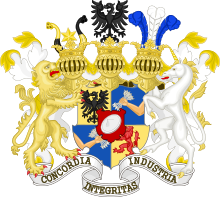Rothschild banking family of Naples
This article has an unclear citation style. (July 2011) |

The Rothschild banking family of Naples (Italian: Famiglia di banchieri Rothschild) was the Neapolitan branch of the Rothschild family. It was founded by Carl Mayer von Rothschild (1788–1855), who was sent to the Kingdom of the Two Sicilies from Frankfurt in 1821.
Endogamy within the family was an essential part of the Rothschild strategy in order to ensure control of their wealth remained in the family's hands. Through their collaborative efforts, the Rothschilds rose to prominence in a variety of banking endeavors including loans, government bonds, and trading in bullion. Their financing afforded investment opportunities and during the 19th century, they became major stakeholders in large-scale mining and rail transport ventures that were fundamental to the rapidly expanding industrial economies of Europe.
By 1820,
Elevation to Austrian nobility
In 1822, the five Rothschild brothers at the head of the family's banks in various parts of Europe were each granted the hereditary title of
Involvement in finance and industry
Carl von Rothschild developed a good working relationship with Luigi de' Medici, the "Direttore della Segreteria di Azienda del Regno di Napoli" (Finance Minister), and his operation became the dominant banking house in Naples. As a result of Carl's success, the Rothschilds had a substantial banking presence in England and three other major European capitals, giving the family considerable influence and an advantage over their competitors. During the winter of 1826,
The bank, C M de Rothschild & Figli, arranged substantial loans to the
The year 1855 was one of considerable change for the Rothschild family with the death of the head of both the Naples and German branches. Of the three sons of Carl von Rothschild, the eldest,
Closure of the Naples branch
The end of the Naples branch began when revolution broke out and
The brothers Mayer Carl and Wilhelm Carl von Rothschild had only daughters (ten in total) and with the 1935 deaths of Emma Louisa de Rothschild (daughter of Mayer Carl) and Adelheid de Rothschild (daughter of Wilhelm Carl), the Neapolitan branch went extinct in the male line.[2]
All branches of the Rothschild banking family are famous for their art collections and a number for their palatial estates. Because the Naples branch was run by just two family members, father Carl Mayer von Rothschild, and son Adolphe, the only great property they occupied there was the
Family members
Members of the Rothschild family of Naples include:
- Charlotte von Rothschild (1819–1884)
- Carl Mayer von Rothschild (1788–1855)
- Bina Rothschild (1902–1965)
See also
- Rothschild family
- Rothschild banking family of Austria
- Rothschild banking family of England
- Rothschild banking family of France
References
- ^ Constantin von Wurzbach (1874). Biographisches Lexikon des Kaiserthums Oesterreich (in German). Vienna: Zamarski. p. 120.
- ^ "Genealogy". The Rothschild Archive. Retrieved 2019-05-06.
- The Rothschilds; a Family Portrait by ISBN 1-56836-220-X(1998 reprint)
- The Rothschilds, a Family of Fortune by ISBN 0-394-48773-7
- A History of the Jews by ISBN 5-551-76858-9
- Rothschild: The Wealth and Power of a Dynasty by ISBN 0-684-19018-4
- House of Rothschild : Money's Prophets: 1798-1848 by ISBN 0-670-85768-8
- The House of Rothschild (vol. 2) : The World's Banker: 1849-1999 by Niall Ferguson. ISBN 0-7567-5393-7
- Charlotte and Lionel: A Rothschild Love Story by ISBN 0-7432-2686-0
External links
- The Rothschild Archive - an international cente in London for research into the history of the Rothschild family.
- The Musical Associations of the Rothschild Family by Charlotte Henriette de Rothschild
